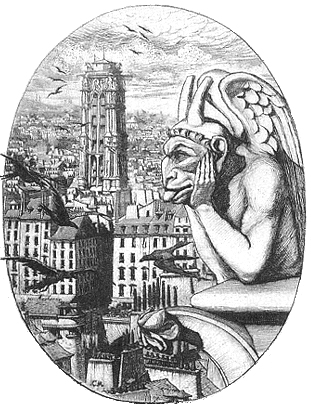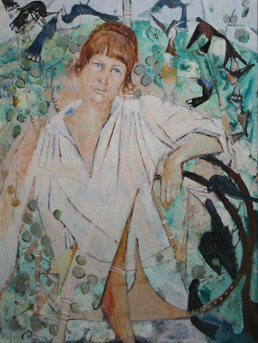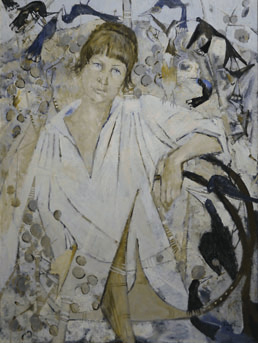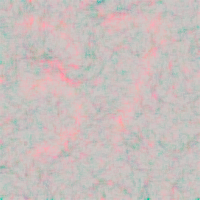In questo articolo del Dr. John R. Skoyles del Centre for Mathematics and Physics in the Life Sciences and Experimental Biology (CoMPLEX) dell’University College di Londra si descrive in termini scientifici la capacità di un affermato pittore daltonico. L’articolo è in inglese, è possibile tradurlo con la funzione che trovare in alto a destra nel sito.
The color-blind can be celebrated artists

No surprise that the French etcher Charles Meryon was color-blind. His Vampire (Le stryge), 1853 above is black and white: as a young man Charles realizing he was color-blind, he decided to focus upon exploring the monochrome world of etching. But what about the portrait below by the three-time winner of Australia’s Archibald Prize, expressionist painter Clifton Pugh?

Pugh was a protanope like his brother and grandnephew. He failed the color vision test when trying to enlist in the Australian Navy. As a protanope he lacked long-wavelength retinal cones that allow more fully color able people distinguish between greens, yellows and reds.
As a result he would have seen his Portrait of Judith 1976 above slightly differently from nonprotanopes as below.

So how did he do it? Perhaps we are a little quick to assume limited color vision is no vision. In the case of Charles Meryon he side stepped his problem with the black and white of etching. But Clifton Pugh seems to have refocused upon the colors he could see. Perhaps he looked at those tubes of green, red and yellow paint next to his easel and saw not similar colors with different names Olive, Ochre, Safron, Gold, Ruby, Vermilion–but a challenge. These paint tubes contained something visually rich to others in a way that were not to him. Is that not a challenge to explore the secret world of those tubes of paint? “What a beautiful yellow”. “What a peaceful green”. One could well imagine him taking a greater interest–at least occasionally–in what was just beyond his vision. Disabilities can often be opportunities that drive creativity–as noted by the theoretical psychologist, Nicholas Humphrey in his piece “Deformed transformed“. The better ability to hear is well known with the blind but the color blind might have visual advantages–though it is unresearched it seems that many bird-watches are color blind and it is possible that impairing the ability to distinguish color might make them better able to see the visual differences in textures, luminosity shading and movement needed to spot and identify birds. Indeed dichromats that have impaired medium-wavelength retinal cones can have better visual acuity and ability to detect fast oscillating visual stimuli.
 Another possibility is that his remaining medium and short-wavelength retinal cones allowed Clifton some sense of the green, red and yellow hues–that the above “decoloring” of his portrait to “protanope vision” does not actually capture what he saw. The missing long-wavelength retinal cones have their peak sensitivity is in the greenish-yellow 564–580 nm region of the spectrum. But this color area is also in the 450–630 nm range of the medium retinal cones. It is only a small part of the spectrum–630-700 nm–that is exclusive to the long cone’s 500–700 nm range that would have been entirely lost to Clifton Pugh. It is colors in this small spectrum that are used to test for being a protanope. But such tests and the lived normal vision of seeing natural scenes are different. Tests may be useful for detecting where vision may be defective in regard to artificial stimuli such as warning lights and thin colored lines on paper maps. But is this limitation so dramatic for all color experiences? The human eye usually sees the world as a complex shading of hue and brightnesses. An artist holding their palette when working up a portrait on a canvas is in a very different situation to judging whether a number appears amongst the dots of a color vision test as on the left? (Note due to the variability of color display on monitors those without protanope may not see the hidden digits.) Clifton seems to show it is not. Color vision tests should not rule out people going to art school or art galleries.
Another possibility is that his remaining medium and short-wavelength retinal cones allowed Clifton some sense of the green, red and yellow hues–that the above “decoloring” of his portrait to “protanope vision” does not actually capture what he saw. The missing long-wavelength retinal cones have their peak sensitivity is in the greenish-yellow 564–580 nm region of the spectrum. But this color area is also in the 450–630 nm range of the medium retinal cones. It is only a small part of the spectrum–630-700 nm–that is exclusive to the long cone’s 500–700 nm range that would have been entirely lost to Clifton Pugh. It is colors in this small spectrum that are used to test for being a protanope. But such tests and the lived normal vision of seeing natural scenes are different. Tests may be useful for detecting where vision may be defective in regard to artificial stimuli such as warning lights and thin colored lines on paper maps. But is this limitation so dramatic for all color experiences? The human eye usually sees the world as a complex shading of hue and brightnesses. An artist holding their palette when working up a portrait on a canvas is in a very different situation to judging whether a number appears amongst the dots of a color vision test as on the left? (Note due to the variability of color display on monitors those without protanope may not see the hidden digits.) Clifton seems to show it is not. Color vision tests should not rule out people going to art school or art galleries.
References
Cole BL, Harris RW (September 2009). “Colour blindness does not preclude fame as an artist: celebrated Australian artist Clifton Pugh was a protanope”. Clin Exp Optom 92 (5): 421–8.10.1111/j.1444-0938.2009.00384.x 19515095
Humphrey, N. (2002), DEFORMED TRANSFORMED The Mind Made Flesh: Essays from the Frontiers of Psychology and Evolution, chapter 14, pages 165-199. Oxford University Press.
For some dichromats having better visual acuity see Jägle H, de Luca E, Serey L, Bach M, Sharpe LT. 2006Visual acuity and X-linked color blindness. Graefes Arch Clin Exp Ophthalmol. 244(4):447-53.
For them having better temporal frequency resolution see Sharpe LT, de Luca E, Hansen T, Jägle H, Gegenfurtner KR. 2006 Advantages and disadvantages of human dichromacy. J Vis. 7;6(3):213-23.
fonte: http://www.human-existence.com/blog/?p=488&cpage=1#comment-310
Si ringrazia per la gentile concessione il Dr. John R. Skoyles,
Centre for Mathematics and Physics in the Life Sciences and Experimental – Biology (CoMPLEX), University College di Londra.

